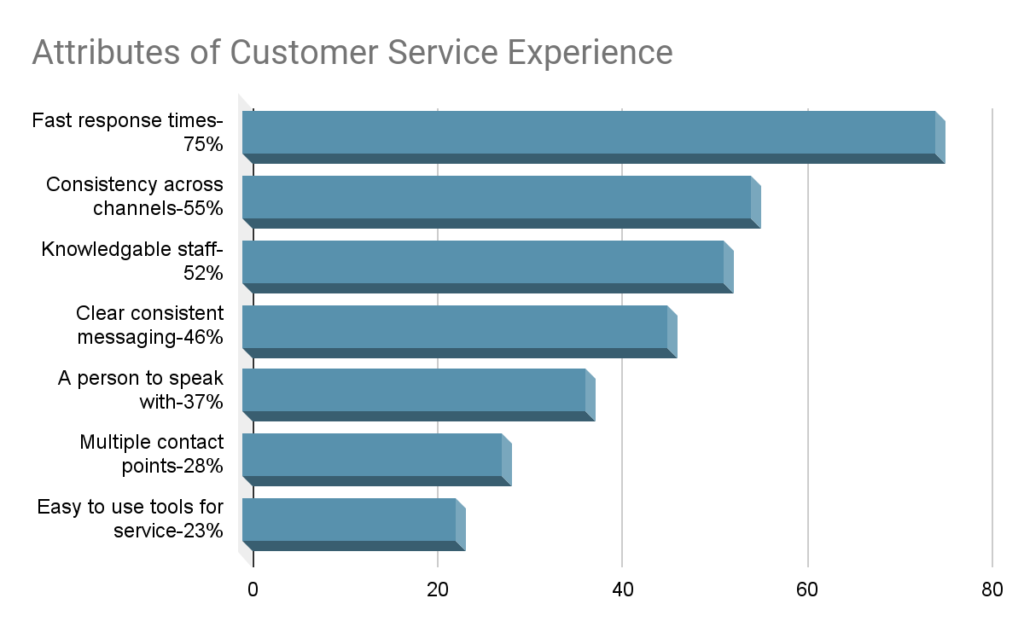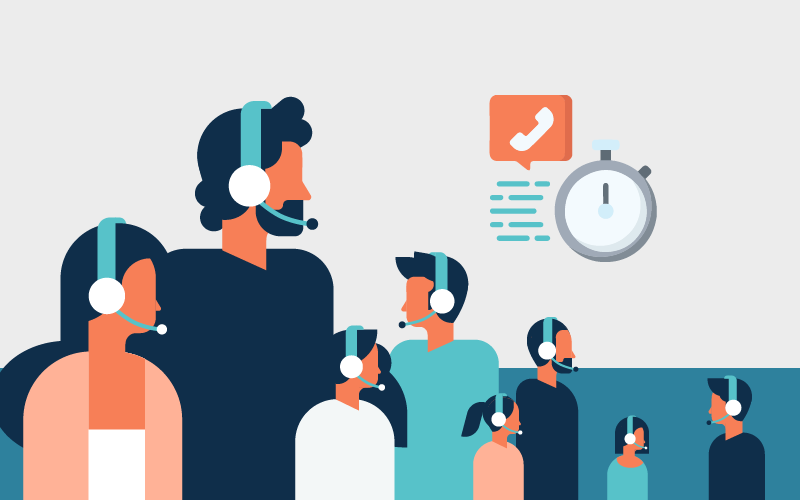Responding fast to customer queries makes all the difference in delivering outstanding customer service. There is no easier way to differentiate yourself from the competition than by improving your first response time.
“66% of customers say that valuing their time is the most important thing a company can do to provide good service.” Forrester
This is why we are here, to help you learn everything you need to know about first response time or FRT.
What is First Response Time?
First response time (First reply time) or FRT is the average time it takes for the customer service agents to provide an initial response to a customer.
FRT is a sign of your organization’s commitment to customer service; the lower, the better. Responding to or acknowledging faster to customer queries makes all the difference when it comes to satisfying customers.
And since customers anticipate quick replies to their questions, FRT is a crucial metric that should never be missed or overlooked.
71% of customers think that receiving a prompt response from the support staff would make their experience significantly better.
Meeting FRT goes hand in hand with improved customer satisfaction, retention rates, and brand trust. However, long wait times for the initial response result in furious customers and a higher churn rate.
According to a report, 40% of millennials wait 60 minutes before contacting you through a different channel.
Why Does First Response Time Matter To Call Centers?
First response time improves customer satisfaction and helps establish your business as a customer-centric one. Read on to learn why FRT matters.
1. Helps you understand how to handle the rise and fall in ticket volumes
Monitoring and analyzing the FRT lets you strategize on aspects such as agent productivity, staffing levels for peak periods or outages, scaling up or down for seasonal demands, and more.
In fact, customers themselves claim that a quick response time is the most crucial component of a positive customer experience as per a study.
2. Helps offer better customer service
A low FRT correlates with improved customer satisfaction. Knowing the FRT encourages you to take the necessary steps to reduce it so that you can stop customers from becoming upset over wait times.
A frustrated customer will more likely turn to your competitors as per studies by Bain and Company. It says, “Service-related problems, like a slow FRT, make customers four times more likely to buy from competitors than price or product-related problems. “
3. Boosts brand loyalty
Fast responses will let you build brand loyalty through great customer experiences. Ultimately, a positive customer experience is what makes the customers come back for more. A base of satisfied customers is vital to building a brand loved by all.
4. Lets you understand the customer’s reaction
Mapping the FRT to NPS, CSAT or CES will let you gain insights into customers’ reactions to long wait times. A higher FRT will often have customers churn or spread negative word of mouth. A lower FRT, on the other hand, will leave customers feeling happy and satisfied.
Most customer service representatives hold the wrong belief that they can wait to answer a question until they obtain the appropriate information. In reality, customers always prefer to be acknowledged at the earliest. As the FRT shows how fast you let customers know that their issue is being addressed, it is often more important than overall response time.

How Do You Calculate First Response Time?
First response time is a vital metric that every business should monitor because delivering an improved response is key to delivering an exceptional customer experience. As every business strives to differentiate itself by providing the best customer experience possible, you must definitely raise your standards to meet FRT.
So in order to get a bird’s eye view of your performance, you need to know how to calculate the first response times.
To calculate FRT, you need two pieces of information.
- The total response time during the selected time frame
- The total number of responses sent within the same time frame
Gather this data for a week or for over a month and feed it to your FRT calculator to get a broader picture of your performance.

If the total time taken to respond to customer queries for over a month amounts to 72000 seconds, for instance, and the number of responses equals 900 for the period, your FRT will be,
72000 seconds ÷ 900 = 80 seconds
For an accurate calculation don’t include automated responses from chatbots and tickets that arrive outside of business hours or SLA.
Once you have your FRT, compare it against the industry average to see what needs to be done to keep up with the desired value. You can compute FRT for an individual agent, team, or social channel.
However, the FRTs vary from channel to channel. The average FRT benchmark for a live chat in all industries is 1 minute and 36 seconds yielding 92% customer satisfaction. – source
Here are some ways to drive down your FRT and improve your customer experience.
Tips To Improve First Response Time
How do you respond to customers’ queries when there are hundreds of tickets to focus on?
Well, don’t worry; the solution is provided below.
1. Automate Support
The more daily tasks you automate the higher the productivity level of your agents. Intelligent contact center solutions offer smart tools such as live chat, ticket tagging, canned responses, workflow automation, customer data management, escalation management, reporting, and analytics to enhance employee efficiency.
Agents can devote more time to complex problems that demand more thought and research when most of the workload is reduced through automation.

2. Train Your Agents
When agents are very well aware of the products, services, company policies, and standard practices, they will be quick to answer customer questions without having to hunt for information. Moreover, new agents can be less efficient, taking longer to resolve issues resulting in subpar service.
To ensure that all agents are up-to-date on the knowledge front it is important that they undergo the right training and frequent upskilling. The best way to do this is by having a Learning Management System to take care of your training needs.
Learning Management Systems or LMS helps you administer, report, track, and deliver learning programs. It lets you upload courses or tutorials that your agents can use to enhance their skill set, also giving them the flexibility to learn from anywhere.
Following a survey by Middlesex University in London, 74% of employees believe they haven’t received the essential training or development necessary to perform to their full potential at work.
A contact center learning management system (LMS) enables you to train your whole workforce, allowing you to increase agent productivity by offering effective, user-friendly, and engaging training.
3. Being Omnichannel
Being omnichannel lets you handle tickets across different channels from a single platform. This lessens FRT as agents can respond right away without having to switch screens. Offering support across social media, email, chat, and call prevents a single channel from being flooded with customer interactions.
Also, it allows customers the convenience of getting in touch with you through their preferred channel.
Leveraging the omnichannel customer experience strategy also gives you access to aggregate data from prior interactions across several channels, which can help you quickly comprehend the context of customers’ inquiries. The result is a lower first response time and a better customer service experience.

4. Comprehensive Knowledge Base
When agents have the information they need to answer customer questions right at their fingertips, your FRT will certainly be at its best. A knowledge base system or a centralized repository of information can be used to store and manage real-time information on company products, services, and policies.
Kapture offers an ‘Agent Assistance Window’ embedded within the ticketing inbox for agents to type in queries. The agent assistant powered by artificial intelligence provides contextual answers to help agents with customer queries.
With the right tools at their disposal, agents can handle everything from straightforward inquiries to intricate technical ones without hassles or wasting their time.
Additionally, having quick access to a customer’s purchasing history, preferences, and demographic data can assist agents in providing personalized services.
5. Prevent Burnout
High volumes of support tickets piling up in the inbox can stress out your agents which in turn may get in the way of accomplishing the response time goals. Therefore, find ways to keep the agents motivated at all times such as by adopting employee engagement programs.
From tokens of appreciation, distribution of goodies and trophies to perks can go a long way in boosting their morale. You can keep a close eye on the agent performance metrics to identify top performers and reward them appropriately.
Improve your Response Time with Smart Contact Center Solutions
Kapture’s user-friendly cloud contact center solutions empower your agents through smart automation to quickly respond to customers while eliminating challenges that hinder their productivity.
Through workflow automation, omnichannel, easy information access, and a host of other productivity aids, our technologies make life easier for your agents.
Additionally, insightful reporting enables you to consistently monitor your FRT goals. So if you are looking to improve your first response time- look no further. Keeping the right balance between first response time and great customer service is easy with Kapture’s contact center solutions.
About the Author | |
 | Seema C Mohan |
| Seema C Mohan is passionate about all things XaaS and loves to write value-added content. She has been in Business Process Management in the past and has published technology articles in journals. | |
,
,
,
,
,
,
,
,
,
,
,
,
,








